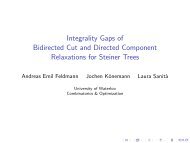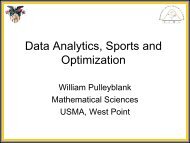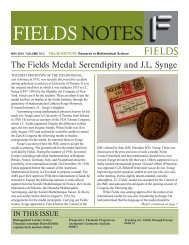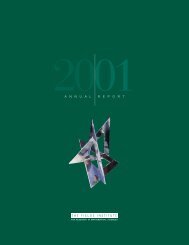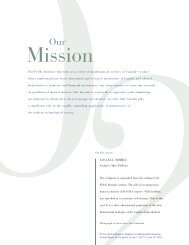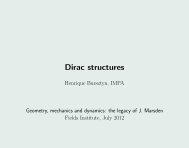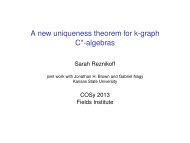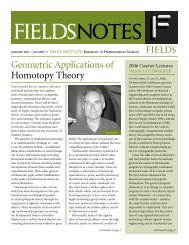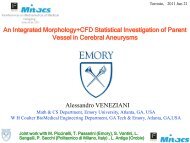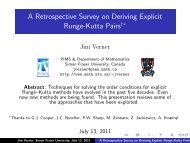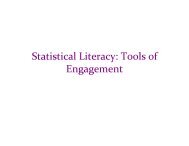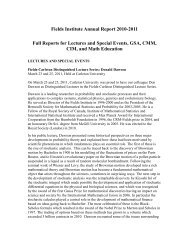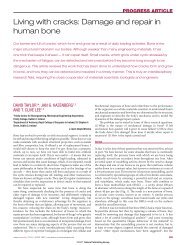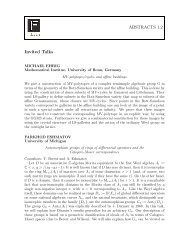Annual Report 2005 - Fields Institute - University of Toronto
Annual Report 2005 - Fields Institute - University of Toronto
Annual Report 2005 - Fields Institute - University of Toronto
Create successful ePaper yourself
Turn your PDF publications into a flip-book with our unique Google optimized e-Paper software.
S. Mitchell (UBC)<br />
An asymptotic framework for finite hydraulic fractures driven<br />
by multiple physical processes<br />
A. Montero (McMaster)<br />
V. Panferov (McMaster)<br />
On the regularity problem for the nonlinear Boltzmann equation<br />
in one space dimension<br />
Mohammad Reza Pakzad (PIMS)<br />
On the weak solutions <strong>of</strong> the degenarate Monge Ampere<br />
equation<br />
Catherine Sulem (<strong>Toronto</strong>)<br />
Nonlinear Schrödinger equations and related systems<br />
A. Tamasan (<strong>Toronto</strong>)<br />
Inverse boundary value problems for the transport equation<br />
and applications<br />
Text Mining Tools for Bioinformaticians and Biologists<br />
February 4, <strong>2005</strong><br />
Held at the <strong>Fields</strong> <strong>Institute</strong><br />
This workshop was organized by the Ontario Centre for<br />
Genomic Computing, at the Hospital for Sick Children, and<br />
hosted by the <strong>Fields</strong> <strong>Institute</strong>.<br />
Many <strong>of</strong> the relationships between biological entities are<br />
captured in scientific text articles where they are difficult<br />
to access and compute on. Biologists have an increasing<br />
need to review the results <strong>of</strong> their experiments in the light<br />
<strong>of</strong> this current knowledge. Experimental data sets are quite<br />
<strong>of</strong>ten very large as are the literature data sets that may<br />
hold information relevant to them. The process <strong>of</strong> placing<br />
experimental results into context requires the help <strong>of</strong> textmining<br />
tools if the task is to be accomplished efficiently<br />
and accurately. The goal <strong>of</strong> this workshop was to bring<br />
together bioinformaticists and text-mining experts from<br />
Ontario and abroad to discuss the challenges and solutions<br />
related to these issues.<br />
Speakers:<br />
Christian Blaschke (ALMA Bioinformatics, Madrid)<br />
BioCreAtIvE: critical assessment <strong>of</strong> information extraction for<br />
biology<br />
G e n e r a l S c i e n t i f i c A c t i v i t i e s<br />
Ian Donaldson (Samuel Lunenfeld Research Inst.)<br />
SeqHound and PreBind: tools for text-mining and consolidating<br />
results for multiple text-mining efforts<br />
Carolina Perez-Iratxeta and Miguel A. Andrade (Ottawa<br />
Health Research Inst.)<br />
Two text mining applications to select and explore MEDLINE<br />
references<br />
Joel Martin (National Research Council Inst. for Information<br />
Tech.)<br />
Rapid text mining across millions <strong>of</strong> abstracts<br />
Alexander Morgan (MITRE Corporation, Bedford MA)<br />
Linking text mentions to biological identifiers<br />
Hagit Shatkay (Queens <strong>University</strong>)<br />
Hairpins in bookstacks: information retrieval for biomedical<br />
informatics<br />
Workshop on the Geometry <strong>of</strong> Very Large Data Sets<br />
February 23–25, <strong>2005</strong><br />
Held at the <strong>University</strong> <strong>of</strong> Ottawa<br />
Organizers: André Dabrowski, Paul-Eugène Parent, and<br />
Vladimir Pestov (Ottawa)<br />
A workshop goal was to bring together researchers and<br />
students from areas <strong>of</strong> statistics, topology and computer<br />
science to explore and identify areas <strong>of</strong> potential research<br />
on the geometric structure <strong>of</strong> very large dimensional data<br />
sets. The essential elements <strong>of</strong> topology and stochastics<br />
were covered the first day by Paul-Eugène Parent, Barry<br />
Jessup and André Dabrowski, all <strong>of</strong> Ottawa. Peter Bubenik<br />
(Lausanne) presented slides <strong>of</strong> Gunnar Carlsson (Stanford),<br />
who was unable to attend, on Persistent homology. Two<br />
talks by Alexander Gorban (Leicester) on How to discover a<br />
geometry and topology in a finite dataset by means <strong>of</strong> elastic<br />
nets engendered numerous side discussions on the computational<br />
and conceptual tools involved. Peter Kim (Guelph)<br />
spoke on Nonparametrics in high dimensions with a particular<br />
emphasis on applications to cometary orbits and<br />
the statistical inverse problem on a Riemannian manifold.<br />
Additional presentations by Peter Bubenik (Lausanne),<br />
Maia Lesosky (Guelph) and Ulrich Fahrenberg (Aalborg)<br />
completed the scientific program.<br />
Despite a short time frame, twenty-five participants in all<br />
enjoyed the workshop. This included senior faculty from<br />
<strong>Fields</strong> <strong>Institute</strong> <strong>2005</strong> ANNUAL REPORT 71



